Various Chinese dishes© Thesomegirl/Getty Images
By Jenny Latreille
Editor’s Note: This article originally appeared as a single article
however part 2 will be presented September 15th.
In North America, we love our Chinese food. From a family dinner at our favorite restaurant to a quick take-out on Friday night, we’re all about the juicy egg rolls, spicy noodles, and sticky sweet chicken balls. But have you ever wondered if you’re making etiquette mistakes when dining out? From simply not knowing how to handle chopsticks to the more nuanced cultural rules, it can be tricky to know what’s right or wrong. For example, showing the soles of your feet (with or without shoes) can be considered quite rude. Because the sole of our foot is in contact with the ground, it’s considered dirty and not looked upon with great reverence. Eating a meal with your legs crossed or, worse, with your feet on the furniture is pretty offensive.
China is a large country with an enormous population, so it would be impossible to cover all the ways you might make your host squirm, but we’ve outlined some of the easiest things to remember here. You’ll obviously find many new and interesting rules governing etiquette within every different region, especially around mealtime. The basic tenets should remain the same, however. Chinese culture places a great deal of emphasis on respect, so if you keep that in mind and act accordingly, you should be able to enjoy your meal with ease. And no matter how much you want to impress your date with mind-blowing chopstick versions of your top-ten favorite drum solos, just don’t do it.
Focusing Only On Americanized Chinese Food
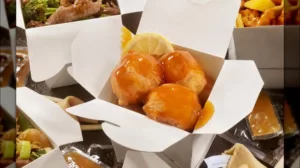
Various Chinese takeout© Lauripatterson/Getty Images
Don’t get us wrong. Obviously, Americanized Chinese food is freaking delicious, with all its deep-fried, sweet, sticky goodness. It wouldn’t be as popular if it wasn’t craveable and utterly fantastic. But if you truly consider yourself an authentic eater, you’d be doing yourself a disservice if you didn’t take a deeper dive into all the incredible, truly Chinese dishes available.
Some of the things you’ve been missing out on include well-known dishes like ma po tofu or dan dan noodles, along with so many other options. You don’t even need to search for a restaurant that specializes in regional cuisine (although we do recommend it, more on that later). Often, even smaller eateries will have a handful of dishes on the menu that are a better representation of true Chinese food for you to try. And when in doubt, don’t be shy to ask. The staff will likely be happy to share their recommendations with you.
Believing That Chinese Food Is Supposed To Be Cheap
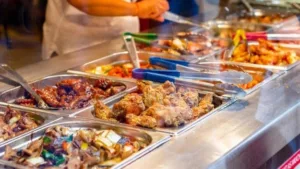
Chinese buffet© I Wei Huang/Shutterstock
One of the biggest misconceptions about Chinese food is that it’s cheap. And sometimes it is — just like those cheap pizza slices we all know and love. But on the whole, Chinese food should be in the same price range as anything else you enjoy. And why not? If it’s been made with quality ingredients by someone dedicated to the pursuit of sharing tasty food that represents their culture, then surely it deserves to be appreciated.
Historically, Chinese restaurants kept prices low in order to attract customers, even if that meant taking a hit in profit. And it worked. But unfortunately, the legacy of cheap Chinese food still lives on, even if those same restaurants aren’t having as much trouble attracting eaters. The problematic and reductive view of Chinese food as cheap means that, as a consumer, you’re likely missing out on terrifically well-made, fantastic food by settling for the all-you-can-eat buffet. We’re not talking about spending more than you can afford; we’re just saying that it might be time to acknowledge that, like other regions, Chinese food should also be priced fairly.
Ordering Individual Dishes For Each Diner
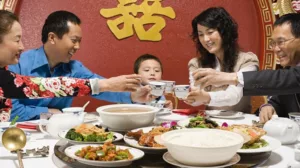
Chinese family eating dinner© Image Source/Getty Images
Meals are a communal activity in Asia, and in China, sharing is highly encouraged. Traditionally, many Chinese restaurants have large wooden lazy susans in the middle of larger tables, something that has gone by the wayside, especially in North America. Some dishes, like soup, are individually served to each diner, but the really tasty stuff is shared with everybody eating.
Think of it like ordering a Chinese dinner for a group of friends, where you get a taste of everything on offer. But it’s more than that in Chinese culture — sharing food forces you to think about others as you’re digging in. Did Grandma get a serving of the char siu? Who else hasn’t tried the dumplings? Rather than just digging into your one-item plateful, you’re tasting all the same things as the rest of your party. One tip for eating a communal meal with chopsticks — rather than serving yourself from the communal plate with your chopsticks, there’s a simple way to deal with this (if no serving chopsticks have been provided). Simply flip those chopsticks around and pick up your serving with the clean ends.
Serving Yourself First
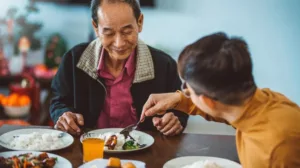
Chinese man serving father© Simon2579/Getty Images
While you’re passing all those tasty dishes around the table, don’t neglect this super important rule of thumb — always serve others first, especially your elders or special guests. No matter how much you want to dig into that plate of tea-smoked chicken, you can be sure that everyone else feels the same way, too. As we mentioned earlier, a big part of the communal meal is paying attention to the needs of your fellow diners, and this extends to making sure that you respect everyone at your table. Look at it this way — you can always order another dish after everyone has had a taste. And this rule extends to more than just chicken; it’s just good manners to serve tea to your elders and special guests first, too.
Now that you’ve passed all those tasty plates around and made sure that everyone has a full plate, don’t get ahead of yourself and start scarfing before everyone else. Just like elders and guests should be served first, wait until they start eating to dig in yourself.
Not Realizing That China Has Many Different Regional Cuisines
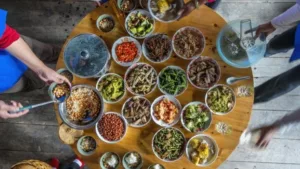
Table full of various foods© Pidjoe/Getty Images
Without turning this into a geography lesson, it’s important to realize that China is a pretty large country and one of the most populated places on Earth. Because of this, there isn’t really one homogenous culture. Instead, China is made up of seven regions, each containing multiple provinces. So what does this mean for your next trip out for dinner? Well, if you’re lucky, you might find yourself at a restaurant that specializes in a specific region’s cuisine, such as Cantonese, Hunan, Sichuan, or Fujian.
It’s true that lots of Chinese restaurants have given in to the notion of Americanization, which only makes sense from a business perspective. But if you dig a little deeper into the menu, you may find items that represent the cultural heritage of a particular region. Take a spin through those offerings to find some truly tasty treats — if you’re unsure, the staff will certainly be happy to help you as they likely have a favorite item or two. The point is, remember that fried rice isn’t a ubiquitous or even true representation of Chinese food. Regional Chinese food varies greatly from one area to another, each with its own styles and flavors.


